Despite uncertainties in the market, consumers did not step back
from the automobile showrooms in November as they felt the ardent
need to change their old cars in the garage. Why wouldn’t they be,
when the average age of vehicles on U.S. roads is almost 11 years
and used cars are worth more at trade-in!
The pent-up demand resulted in an impressive 10.6% rise in sales
to seasonally adjusted annual rate (SAAR) of 13.6 million units in
November from 12.28 million in the same month of 2010 while total
deliveries went up 13.9% from the year-ago level. November was the
third straight month when annualized vehicle sales have topped 13
million mark.
The SAAR of 13.6 million units is also the highest sales rate
since August 2009 when the U.S. government launched the “Cash for
Clunkers” trade-in incentive program. It is also a significant
improvement from 12.6 million units for the first 10 months of the
year.
The pent-up demand during the month was so strong that it even
bypassed the effect of a rise in average vehicle price during the
month. According to industry-tracking firm TrueCar.com, average
vehicle price increased 4% to $30,000 in November.
Further, it was effective in boosting the demand for trucks,
vans and sports utility vehicles (SUVs) as well as the luxury
lineups like Mercedes and BMWs. The gas-guzzling trucks, vans and
SUVs always remained the high-margin products for the automakers
compared with the passenger cars before the economic recession that
forced many automakers (especially the “Big Three”) to change their
product mix.
So, are we heading into the pre-recession era in the automotive
industry? Before dealing with this question, let us delve into the
sales numbers by individual automakers.
Sales by Automakers
Chrysler, Daimler (DDAIF), Ford
Motor (F), Hyundai, Nissan Motor (NSANY)
and Volkswagen (VLKAY) were among the automakers
posting double-digit gain in sales in November. Among the Japanese
automakers, Toyota Motor (TM) saw its first sales
gain since April while Honda Motor’s (HMC) sales
were disappointing due to severe flooding in Thailand.
U.S.Automakers
General Motors Co.’s (GM) sales grew 6.9% to
180,402 vehicles, driven by strong demand for both cars and trucks.
Sales of the Silverado pickup truck surged 33.7%, while that of
Tahoe SUV soared 32.8%. Meanwhile, sales of Cruze compact car
jumped 64.1%.
Ford’s sales escalated 13.3% to 166,865 vehicles, driven by
strong sales of trucks and SUVs that more than offset the drop in
cars sales. Sales of SUVs zoomed 29.3% to 52,881 units, while that
of trucks swelled 22.8% to 65,732 units. The company’s top selling
vehicle was F-Series pickup trucks, which recorded a 23.9% rise in
sales.
Chrysler Group LLC – controlled by Italy’s Fiat SpA
(FIATY) – sales leapt 45% to 107,172 vehicles, driven by
about ten-fold increase in sales of Jeep Compass small SUV. Sales
of the company’s Jeep brand jumped 50%, while that of Chrysler
brand nearly doubled on strong demand for its 200 and 300 sedan
models.
Japanese Automakers
Toyota recorded a 6.7% rise in sales to 137,960 cars and trucks.
The automaker’s car sales were better than truck sales, with the
Prius hybrid sedan posting a 43% improvement in sales.
Honda’s sales dipped 6.4% to 83,925 vehicles due to production
disruptions in Thailand. However, its Civic sedan and Pilot
crossover sport utility vehicle did well during the month with 3.4%
and 38.1% rise in sales, respectively.
Nissan, the least hurt automaker by the twin disaster in Japan,
saw a 19.4% rise in sales to 85,182 vehicles during the month under
study. Nissan Division sales grew 21.5% while Infiniti vehicles
sales inched up 3%. The company’s best selling models during the
month included Versa sedan, Rogue crossover, Frontier pickup and
Pathfinder truck.
Other Automakers
Daimler posted an impressive 55.2% rise in sales to 28,255
vehicles led by strong sales of C-Class and E-Class lineups. The
company’s all-new 2012 sporty C-Class – aimed at luring the younger
and first-time Mercedes-Benz buyers – performed extremely well with
a 112.7% rise in sales to 8,358 units.
Hyundai Motor (HYMLF) sales went up 22% to
49,610 vehicles, driven by strong sales of Elantra and Sonata. The
Korean automaker succeeded in grabbing the market share from top
Japanese automakers, who suffered from production disruptions on
the back of twin disaster in Japan.
Volkswagen posted a 41% rise in sales to 28,412 units on strong
sales of Passat and Jetta. Passat sales totaled 6,018 units
compared with 374 units in November 2010, while Jetta sales totaled
12,891 units, a 15.6% increase over last year.
Conclusion
The sales trend during the month clearly indicates a shift in
consumer paradigm in the automotive industry given the recessionary
conditions in the U.S., including higher unemployment rate (9%) and
surging food and clothing costs, as well as the eurozone
crisis.
Although the recovery in auto sales can be deduced with the help
of pent-up demand theory and incentives, we cannot overlook the
turnaround in consumer confidence.
The urge to fulfill the pent-up demand by the consumers clearly
indicates a well-thought move taking any recessionary effects into
account rather than a hastened decision to grab the dealer
incentives. In this regard, we can recall Robert E. Lucas Jr’s
Rational Expectations Model, which states that agents’
expectations are assumed not to be systematically biased and use
all relevant information in forming expectations of economic
variables.
It is possible that sales could soften once the buyers’ pent-up
demands are exhausted. Nevertheless, we think it would reach close
to the pre-recession level rather than moving downward.
DAIMLER AG (DDAIF): Free Stock Analysis Report
FORD MOTOR CO (F): Free Stock Analysis Report
FIAT SPA (FIATY): Free Stock Analysis Report
GENERAL MOTORS (GM): Free Stock Analysis Report
HONDA MOTOR (HMC): Free Stock Analysis Report
NISSAN ADR (NSANY): Free Stock Analysis Report
TOYOTA MOTOR CP (TM): Free Stock Analysis Report
Zacks Investment Research
Mercedes Benz (PK) (USOTC:DDAIF)
Historical Stock Chart
From Jun 2024 to Jul 2024

Mercedes Benz (PK) (USOTC:DDAIF)
Historical Stock Chart
From Jul 2023 to Jul 2024
